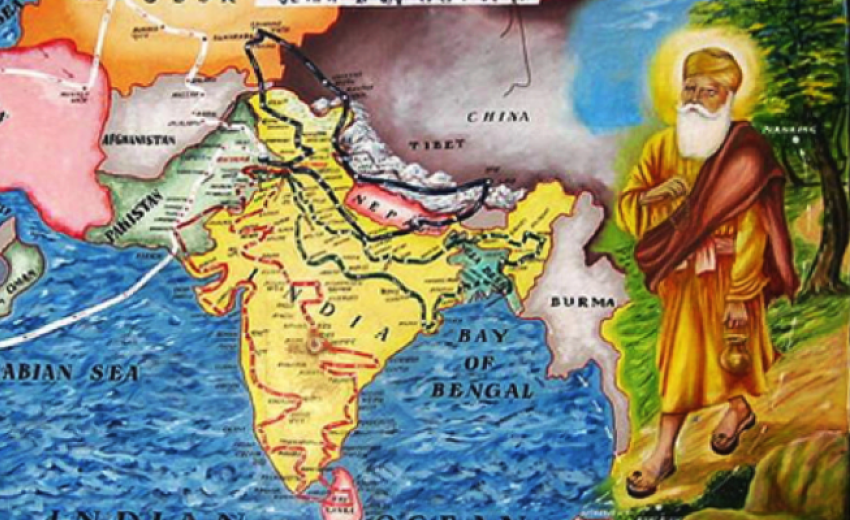What is universal? Universal is that which is applicable everywhere, to whole humankind, and in all civil societies regardless of culture, race, sex, religion, nationality, sexuality, or any other distinguishing feature. In theology, universalism is the doctrine of universal application of the teachings of religion or Dharma. Further, universal can be relevant only in the world of diversity. Without a diverse universe, a universal cannot be applied.
Let us apply the dynamics of universality to Sikhi to establish that they are universal. To start with, the Sikhi dynamics are universal because the founder of the Sikhi claimed them to be so. When we go deep into the Guru’s teachings, we find a dynamic relationship between Sikh identity, Sikh community, and the grace-awakened values that our Gurus prescribed in our scripture. It is the need of the hour that they are articulated in the language that the new civilizations can grasp. Where their universality is not apparent, we must actively explore ways of discovering the universality in the Guru’s message.
What I am talking about may take many efforts and many articulations to cover the subject adequately. Here I will start with a powerful metaphor that the Founder of Sikhi or Gurmat, Guru Nanak, employed to describe the universality of his Dharma.
Metaphor of Ocean and Rivers
Guru Nanak used the metaphor of the ocean waters that through the routes of cloud formations give birth to glaciers, lakes, and rains. They, in turn, go on to form rivers and rivulets. These rivulets then flow through mountains and lands to irrigate vast territories on all continents before they return to the oceans again.
The rivers and rivulets originate at different locations throughout the world, in different geographical areas, in different seasons, and in various formats, sizes, and strengths. They flow in different directions. They carry varied contents and compositions of nutrients or minerals through vast distances. On their way, the rivulets carry diverse materials that may even give them different colors. They nourish widely differing soils and vegetation that give birth to a wide variety of foliage, vegetations, life forms, and ultimately even different civilizations.
Then, they nourish widely differing soils and vegetation that give birth to a wide variety of foliage, vegetations, life forms, and ultimately even different civilizations.
My stressing so much on the vastness and diversity among the rivulets is actually stimulated by a verse from Sri Guru Granth Sahib (SGGS) that was spoken by Guru Nanak, the founding light of Sikhi.

Ocean, Rains, and Rivulets of Sikhi – Gurmat Dharma
There is a striking verse in SGGS, the Sacred Sikh Scripture. Its author was the founder of Sikhi sometime known as Sikhism. Guru Nanak wrote:
ਗੁਰੂ ਸਮੁੰਦੁ ਨਦੀ ਸਭਿ ਸਿਖੀ ਨਾਤੈ ਜਿਤੁ ਵਡਿਆਈ ॥
Gurū samunḏ naḏī sabẖ sikẖī nāṯai jiṯ vadi āī.
The Guru, the Divine Wisdom, is the bottomless ocean, and all of its WISDOM in the form of teachings -Sikhi- originate out of this ocean as rains and falling ice to form rivulets and rivers, sometime puddles. They are of many lengths and depths. When drenched through these rains and rivulets the earth and the life it supports is exalted.
– Guru Nanak. SGGS, p. 150
Ocean and streams here are used as metaphors; ocean for Guru’s wisdom and streams for Sikhi or the institutions of dissemination. Ocean of sacred knowledge is depthless. The water of Knowledge vaporizing from this ocean creates clouds, raindrops, and snow. In turn, they descend on earth in the form of rain and showers. Finally, all of them give birth to rivulets, rivers, and sometimes, puddles all over the diverse earth. When they are in the format of SABD (hymn from SGGS) using the language of Sikh tradition, then they are said to form rivulets of Sikhi.
Thus, the rivulets are metaphors describing practices of Sikhi doctrines and operation of Sikh strategies some of which give birth to Sikh institutions all around the world. But they are always universal as they serve all civilizations in all continents.
These institutions in the form of rivulets flow in numerous variations to suit the varied landscapes. These landscapes consist of wide-ranging temperaments that are innately thirsty for the spiritual water flowing in rivers of many traditions, colors, and mode of things for their spiritual survival as well as the growth of their missions.
As rivulets vary in shape, size, speed, and quality of water they distribute, so are the Sikhi doctrines and practices. Both of them adapt to numerous variations depending on the terrains of particular geographical or cultural expanse. Their shape and external formats are formed by widely differing cultural landscapes and linguistic temperaments. However, their purpose is one, to nourish the earth and its humanity with ONE Universal consciousness. The intention is to nurture the divine creation in the schema of Divine Creativity.
Different landscapes receive the thirst-quenching waters in various ways, sizes, shapes, and colors to benefit each one of the terrains in their own peculiar and varied traditions.
Briefly what these metaphors mean concerning the present and future of Sikhi is as follows.
Guru’s wisdom originating from SABD Guru is dispensed to diverse populations and cultures. The recipients may be of varieties of mindsets throughout the world, the world which is varied from place to place. The wisdom is dispensed in a wide range of ways, even under different designations, names, and titles.
Thus, the ways of Sikhi would overtly look and feel diverse, but inside they are universal and carry the same fundamental doctrines and wisdom. Their purpose is one, to nourish the human mind with one universal knowledge towards ONE Universal Consciousness, to ultimately take all humanity back to their source, the OCEAN, the Creator.
Cloud Burst
There is a beautiful story from the Guruship of Guru Ram Das reported by Sikh historian, Bhai Santokh Singh.
A delegation of Hindu religious scholars under the leadership of Pundit Mohan Lal came to visit the Guru. The members were well-known Pundits or leaders from Brahmanical tradition. Their mission was to express their concern with the language and mode of propagation the Guru was using to freely dispense Gurmat message among the people.
They loudly expressed their concern. The delegation attempted to persuade the Guru to use the language of the religious elite, the Sanskrit, to impart Guru Nanak’s doctrines. Further, the same elites should be given charge to also reveal the sacred knowledge to the ordinary citizen.
 The Guru is reported to rebuke the suggestion and used the same metaphor of rain as related above to make his point forcefully. Bhai Santokh described it as:
The Guru is reported to rebuke the suggestion and used the same metaphor of rain as related above to make his point forcefully. Bhai Santokh described it as:
ਬੇਦ ਪੁਰਾਨ ਕੂਪ ਜਲ ਜੈਸੇ।ਬਰੋਸਾਇ ਕੋ ਕਿਤੀ ਜੈਸੇ
ਸਤਿਗੁਰ ਬਾਣੀ ਮੇਘ ਸਮਾਨ ।ਬਰਸੈ ਚਹੁੰ ਦਿਸਿ ਬਿਖੈ ਜਹਾਨ ॥
Divine knowledge in Sanskrit or Arabic is like the needed water being buried in deep wells. It takes the effort to draw it out and then quench the thirst of the person drawing it out or to irrigate crops of only those who possessed the means of taking out water in this manner. No sharing was likely as the quantity of water thus drawn was sufficient just to satisfy the needs of the holder of the bucket.
In contrast, the Guru’s Wisdom, Sikhi or Gurmat, was manifested in Gurbani (Guru’s repository of knowledge and findings) in a language which served as a cloudburst. It turned the crops of everyone and in every field, green; it reached mountains and valleys alike, birds and mammals alike, animals and human alike, educated and uneducated equally, poor and affluent alike. (See Santokh Singh, Sri Gur Partap Suraj Granth, Raas 1, Part 46, p. 1518. Reprinted Amritsar, Khalsa Samachar, 1954.)
The Guru’s verdict was akin to a biblical parabola.
Jesus is known to have said: "When you light a lamp place it at a higher pedestal so that the light can reach everyone."
Universality and Diversity Inseparable
It may be pointed out that the metaphor from the Guru Granth as described above also implied the appreciation of high diversity observed in all civil societies and faiths. For example, As Guru Amar Das said, Diversity is a Divine Order. Guru wrote,
ਮੇਰੈ ਪ੍ਰਭਿ ਸਾਚੈ ਇਕੁ ਖੇਲੁ ਰਚਾਇਆ ॥ ਕੋਇ ਨ ਕਿਸ ਹੀ ਜੇਹਾ ਉਪਾਇਆ ॥
My True Creator has staged a play. He has created no one like anyone else.
Guru Amar Das, SGGS, p. 1056.
Without an appreciation of diversity, universality cannot be practiced. Diversity provides a necessary opportunity to practice universality.
Conclusion
Our clergy frequently talk about their message being universal. Moreover, our clergy, exegetists, and even scholars stress loudly and with authority as well as with pride that our Gurus gave us a religion that is universal.
However, our clergy and exegetists never elucidate what they mean from the Sikhi teachings being universal. As a matter of fact, in the name of their universal religion, they religiously promote rituals, definitions, and religiosities which are out and out anything but universal. This is seriously limiting the spread of Sikhi faith and the Sikhi followings.
Guru Nanak, several centuries ago, used the metaphor of ocean for the divine wisdom that serves the humanity as the nourishing water of rivulets all over the earth. By saying so, Guru Nanak also inculcated the recognition of vast diversity that the Creator had desired of the Creation.
Calling Sikhi as rivulets, the founders were explicit: Sikhi would never formally align Guru Wisdom with one ethnicity, one society, one culture, one denomination, one political party, or one geographical area. Guru will also not allow someone to use a Sikhi rivulet to ignore laws of civil societies, of sciences, or of colors and diversities within the same community. As far as we know, that was the intent of Guru Nanak.
There is another point to ponder. A rivulet is a minority if you look at one at a time, but it is the majority if you look at it “connected to the source along with others and its ending into the ocean with all others.” Then you are part of a vast majority. This way the Wisdom Seekers encounter the coming waves of global uncertainty with confidence and optimism.






